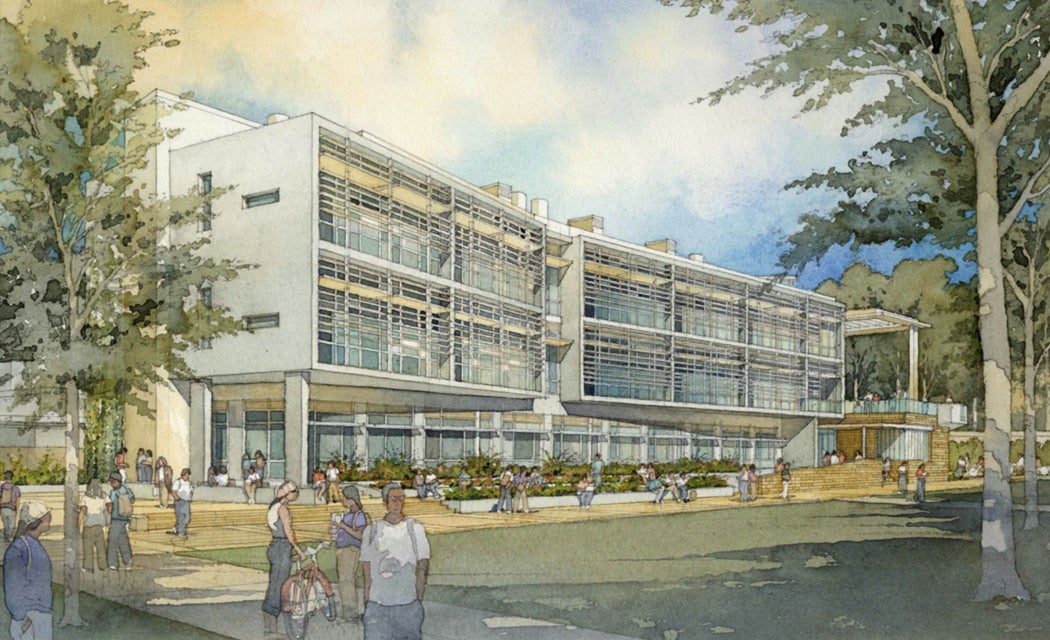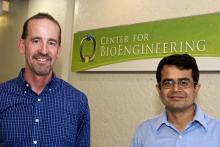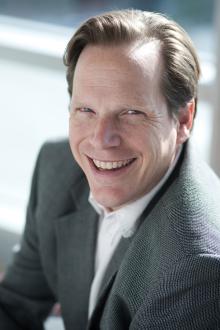


A new center at UC Santa Barbara has the development of an artificial pancreas in its sights, as well as new biomaterials, new tools for the detection and diagnosis of disease, and new mechanisms for drug delivery –– among other cutting-edge scientific developments.
UCSB's new Center for BioEngineering (CBE), proposed by Frank Doyle, associate dean of research in the College of Engineering, was approved earlier this year by the Academic Senate. The Center is a locus of research and teaching –– at the interface of biology, engineering, and physical sciences –– that is already producing results that benefit industry and medicine. Research at the CBE is yielding important advances in the understanding, diagnosis, and treatment of common and devastating diseases such as cancer, diabetes, Alzheimer's, and macular degeneration.
CBE builds on UCSB's interdisciplinary strengths in biophysics, biomaterials, biomolecular discovery, and systems biology, which allow for fundamental scientific discoveries to be transitioned to applications in medicine and biotechnology.
"UC Santa Barbara is very proud to be the home of the new Center for BioEngineering," said Chancellor Henry T. Yang. "The creation of the CBE marks a major step forward for our campus. In this highly interdisciplinary field, UCSB is already at the forefront. Our new Center will consolidate our position and support groundbreaking research aimed at finding innovative solutions for the diagnosis, treatment, and prevention of disease."
Samir Mitragotri, the founding director of the Center and professor of chemical engineering, emphasizes the importance of CBE as a "home" for bioengineering on campus, since bioengineering is already an area of research in many of UCSB's centers, institutes, departments, and colleges.
"I expect that the Center will enable opportunities in terms of new fundamental understanding of disease mechanisms, and research at the interface of physical sciences, engineering sciences, medicine, and biology," said Mitragotri. "That includes understanding and development of new technologies to either diagnose or treat a disease."
Kevin Plaxco, associate director of the CBE, and professor of chemistry and biochemistry, noted that UCSB's researchers in bioengineering are publishing many papers in the field, and these papers have had major impact, as measured by the number of other researchers who cite these studies. "By those objective standards, UCSB is a real powerhouse in the field without historically having a department or program, or any other focal point called bioengineering," he said.
Plaxco defined bioengineering as being comprised of three intellectual thrusts:
Biomedical engineering, traditionally defined as engineering applied to biological and medical problems.
Engineering of biological systems, the engineering of biological systems or the creation of things that mimic biological systems as a means of solving a pressing technical need. That is, using biology for engineering purposes.
Using the engineering perspective to elucidate how cells and organisms function. In other words, applying what we have learned in the fields of engineering to our understanding of the inner workings of biology.
In the area of engineering things that mimic biological systems, Plaxco cited research by Herb Waite, professor in the Department of Molecular, Cellular, and Developmental Biology. Plaxco said that Waite's research into the glues that marine mussels use to attach themselves to rocks and pier pilings could eventually lead to the development of synthetic analogs to be used as surgical and industrial adhesives that function in similarly challenging, wet-and-changing environments.
Plaxco explained that the third branch, looking at biology from the perspective of engineering, is particularly strong at UCSB. The field is growing rapidly on campus, he said, noting that faculty from departments across UCSB are looking at biology as an engineer would, asking what the control mechanisms are by which cells regulate their metabolic pathways. These researchers are defining the parameters that nature itself monitors and adjusts to get these complex systems to work robustly and routinely.
CBE has collaborations with several medical institutions, including the Sansum Diabetes Research Institute, the Sanford-Burnham Medical Research Institute, the Morgridge Institute for Research, and Santa Barbara Cottage Hospital. Doyle oversees medical partnering opportunities.
Sansum Diabetes Research Institute in Santa Barbara has a nine-year, collaborative bioengineering project with Doyle's research group. Besides his position as the associate dean of research in the College of Engineering, Doyle is a CBE faculty member, director of UCSB's Institute for Collaborative Biotechnologies (ICB), professor of chemical engineering, and the Mellichamp Chair in Process Control.
"Our goal is a completely automated artificial pancreas that will restore a normal lifestyle to individuals with type 1 diabetes, said Doyle. "Our researchers have guest investigator appointments at Sansum, and some of the M.D.s have adjunct faculty status at UCSB."
He noted that some Sansum physicians are conducting research on campus.
"I am delighted with the development of the Center for BioEngineering on our campus," said Jamey Marth, director of the Center for Nanomedicine (CNM) and a faculty member of CBE. "I believe that the CBE will play a major role in the convergence of the physical and biological sciences leading to important biomedical and therapeutic advances. Myself, other members of the CNM, and the faculty of the Sanford-Burnham Medical Research Institute look forward to working together to achieve these exciting goals."
Some of the key research efforts of faculty in the Center for Bioengineering include the following:
Detection and diagnostics. UCSB researchers working at the interface of engineering and the molecular sciences are creating a new paradigm for point-of-care diagnostics. In particular, CBE researchers are using advanced microfluidics and molecular signal transduction to develop broad new classes of rapid, cost-effective diagnostic tools.
Systems biology and discovery tools. Researchers at the CBE use advanced computational methods and high throughput experimental biology to understand complex biological systems. They aim for insights into ailments such as cancer, diabetes, Alzheimer's, stroke, hemorrhage, and post-traumatic stress disorder.
Biomaterials are a crucial component of modern medicine. They are at the heart of revolutionary medical technologies such as prostheses, regenerative medicine, sensors, and drug delivery. UCSB researchers are developing new biomaterials that have better functionality, processability, and biocompatibility.
Drug delivery refers to the science and engineering involved in converting potent biomolecules into practical medical therapies. Pills and injections are the most commonly used means of drug delivery, but CBE researchers are exploring revolutionary new ways to treat diseases such as diabetes, cancer, and cardiovascular diseases with much greater precision and efficiency. Methods they are exploring include using nanoparticles; using self-assembling nanomoleculars to deliver drugs to particular sites in the body; and using needle-less systems to deliver drugs through skin patches and oral pills.
The Center will ultimately be housed in a new, state-of-the-art BioEngineering building, scheduled to open in 2014. The three-story, 48,000-square-foot structure will accommodate laboratories and offices for approximately 15 faculty members and their graduate students, as well as administrative offices, and a 100-seat auditorium. It will be the home of both the CBE and the ICB. Construction is expected to begin in 2012.
Moore Ruble Yudell Architects and Planners of Santa Monica designed the building, which will include elements of Santa Barbara style. The building has been designed from the ground-up to be highly energy-efficient, meeting the Leadership in Energy and Environmental Design (LEED) Silver standards set by the U.S. Green Building Council.
Other facilities used by CBE faculty are the Materials Research Laboratory, the Engineering Science Building, and the California NanoSystems Institute.
The Center is part of the University of California's Bioengineering Institute of California, which consists of 10 campuses and three national laboratories.
CBE efforts will be carried out by scientists in UCSB's College of Engineering; Mathematics, Letters, and Physical Sciences, in the College of Letters and Science; the Department of Chemical Engineering; the Department of Mechanical Engineering; the Department of Electrical and Computer Engineering; the Department of Physics; the Department of Chemistry and Biochemistry; the Department of Psychological and Brain Sciences; the Department of Ecology, Evolution, and Marine Biology; the Materials Research Laboratory, the Department of Molecular, Cellular, and Developmental Biology; the Materials Department; the Institute for Collaborative Biotechnology; the Neuroscience Research Institute; the Center for Stem Cell Biology and Engineering; the Center for the Study of Macular Degeneration; the Center for Nanomedicine; and the California NanoSystems Institute.
Related Links



